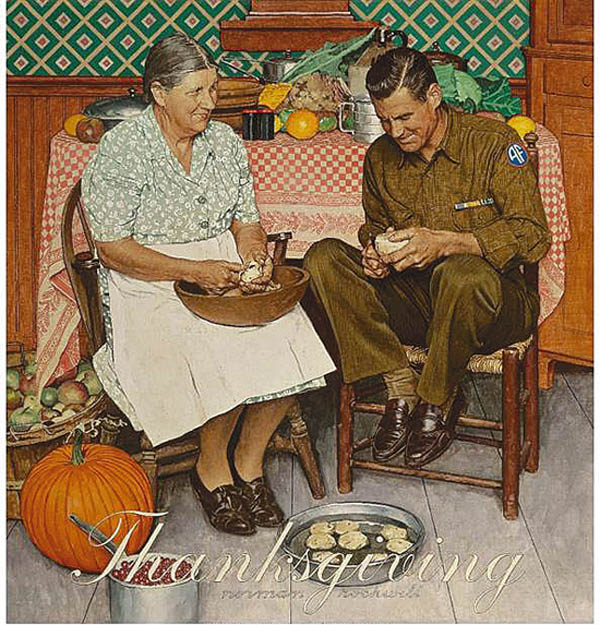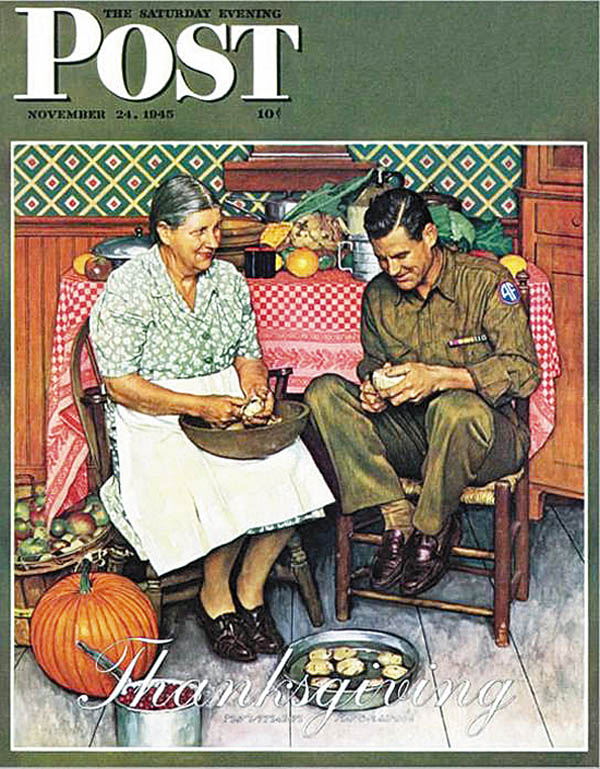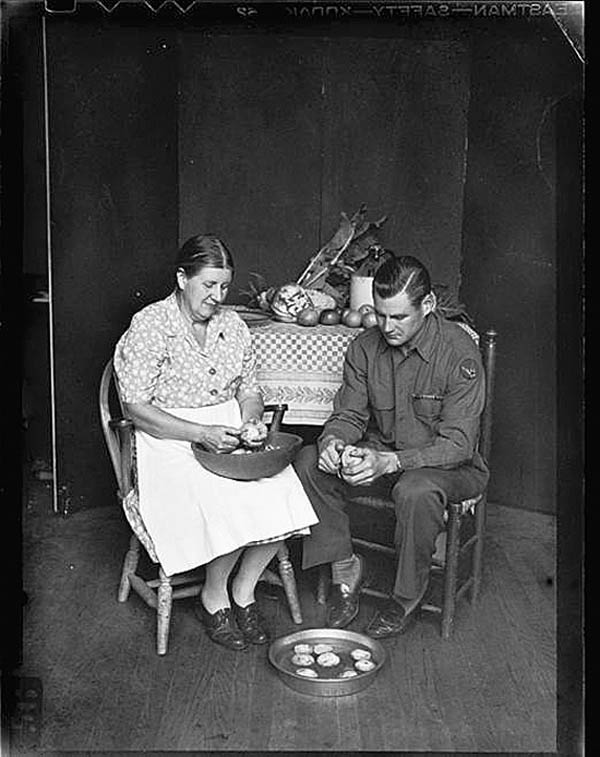Norman Rockwells 1945 Masterwork Home For Thanksgiving To Make Auction Debut
Original Painting For The Saturday Evening Post Cover To Be Centerpiece Of Heritage Auctions’ Nov. 5 American Art Sale
October 29, 2021
For years, the painting hung in the hallway of a Massachusetts American Legion Post, alone, unattended, on a wall near the front door, where anyone could have walked out with it, Ken LaBrack says with a small laugh. For years, no one cared too much about the fate of the painting, because they thought it was nothing more than a reproduction of Norman Rockwells Home for Thanksgiving, which first appeared on the cover of the Nov. 24, 1945, issue of The Saturday Evening Post. LaBrack, a past commander at the Eugene M. Connor Post 193 of Winchendon, Mass., says it wasnt until someone walked in and offered $500 for the work that the posts officers began paying attention to the work. Maybe this was far more than just a beautiful fake. So one day in the early 1970s, the painting was pulled from the wall and driven to the Norman Rockwell Museum in Stockbridge, which is a two-hour car ride from the post. Officials at the museum examined the work and delivered their verdict. It was is an original. Post officials, staggered by the revelation, loaned the painting to the museum for safekeeping, and for nearly five decades this enduring image of a mother and her soldier son happily peeling potatoes for Thanksgiving dinner remained in the care of the Rockwell Museum. Its custodians displayed the work and occasionally toured it across America and around the world, most recently as part of the Enduring Ideals: Rockwell, Roosevelt & the Four Freedoms exhibition. Now, for the first time, Rockwells historic, beloved Home for Thanksgiving heads to auction, serving as the centerpiece of Heritage Auctions American Art Signature Auction set for Friday, Nov. 5. It is estimated to sell for upwards of $4 million, befitting its status as one of Rockwells most enduring series of works featuring soldiers returned home from World War II. It stopped my heart the minute I saw it, says Aviva Lehmann, Heritage Auctions director of American Art. Anyone who sees this painting stops in their tracks, not just because its a classic Rockwell, but because it pulls on their heartstrings. The post is now parting with the painting for practical reasons; it needs the proceeds to fund long-delayed repairs on an aging, decaying building, which LaBrack says were being put off because we didnt have the money. The remaining proceeds will go into a trust, from which the interest and earnings will pay bills, operating costs and further repairs. There are some 500 active members, said LaBrack, as well as 160 Sons of the Legion and another 125 auxiliary members. How the post wound up with the painting, also known as Thanksgiving: Mother and Son Peeling Potatoes, is a Rockwellian short story on its own. LaBrack says that decades ago, the post began looking at building a new headquarters and seeking donations for its construction. A priest named Father Wilfred A. Tisdale caught wind of its efforts and offered by way of donating one of the paintings he kept in his private collection. Tisdale was well known around the area. In 1942, he constructed on the shores of Lake Monomonac a rock-and-concrete structure resembling the bow of a boat called the Santa Maria. The structure served as Tisdales vacation retreat, according to the Winchendon Springs Lake Association, where he displayed his collection of rare works of art of genuine museum quality gathered on trips around the world. LaBrack, a Navy veteran, says Tisdale brought a Legion representative to his retreat and offered any of his paintings to help fund the new building. There were 10 paintings leaning on the floor, not even hung up, LaBrack says. The Legion member walked up and down and said, How about that one for the post, because it has the Army guy with his mother peeling potatoes? And Father Tisdale said OK. He also said, Hang on to this for as long as you can. Tisdale surely knew what he had, one of Rockwells legendary homecoming pieces painted as war began transitioning to peacetime. For The Saturday Evening Post he painted myriad images of the soldier home from war, including the iconic Homecoming GI that appeared in May 1945 and was famously used in the film Broadcast News. Home for Thanksgiving became so beloved because it showed the veteran doing K.P. (kitchen patrol) and liking it, Rockwell says in the 1946 book, Norman Rockwell: Illustrator. According to an editor at The Saturday Evening Post, Rockwells initial intention for the Thanksgiving cover in 1945 consisted of a large group of prayerful people giving thanks, says the Norman Rockwell Museum on its website. With the end of war already in sight, art editor Ken Stuart advised Rockwell to work on a picture of a returned soldier. The gist of Rockwells picture is that the soldier is glad to do at home what he hated doing in the Army. The mother and son in the painting were, in fact, mother and son. Sarah (often referred to as Saara) Hagelberg and her boy, Richard, who was owner of a dairy farm in Arlington, Vt., and Rockwells milkman. Richard had spent the previous five years in the 9th Army Air Corps; according to the blog Only in the Republic of Amherst, he flew 65 treacherous daylight bombing missions over Europe, including D-Day. Richard had just returned home when Rockwell asked him to pose for the piece. He and his mother initially refused, and relented only when the artist offered them each $15, at the time no small amount of money. Legend has it Rockwell offered Richard the painting after its publication, per his usual custom, but the soldier declined. Within two years it was sold to Tisdale. As this is by Rockwell, the maker of immortal moments, the work is no less resonant today than it was 76 years ago. It appears in countless Rockwell books and compendiums, among them Telling Stories, a collection of essays accompanying an exhibition of Rockwells owned by filmmakers George Lucas and Steven Spielberg. Rockwell created many pictures depicting the war as experience on the home front, by workers, kids, parents, and loved ones waiting for the soldiers return, film critic Todd McCarthy wrote in Telling Stories. Along with the Freedom quartet, the simplest, most eloquent and moving of these are his various depictions of homecomings. He had worked in this vein at the end of World War I, albeit in a comparatively obvious fashion. But his 1945 World War II series, including The Homecoming, Homecoming Marine and Thanksgiving: Mother and Son Peeling Potatoes were all so fleshed out and piercing that they could have been scenes from movies. In their emotional impact, they anticipated the heart-stopping moment when Al Stephenson (played by Fredric March) quietly returns to his family after years at war in William Wylers Oscar-winning The Best Years of Our Lives (1946), wrote McCarthy. The post is sad to see it go, but knows, too, that its time to let someone else own it after all these decades. A reproduction now hangs in the hallway. For more information, visit www.HA.com.




SHARE
PRINT